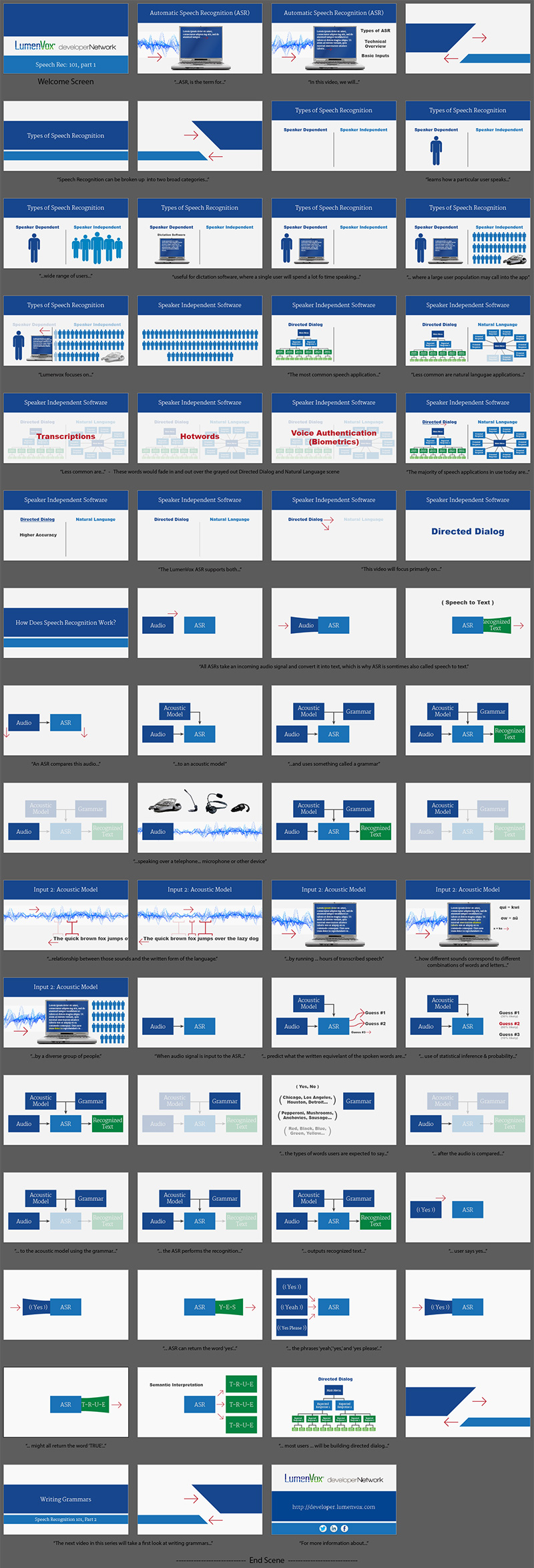Tara Jensen – UX Research & Design

The Project
LumenVox is a B-to-B company that specializes in Speech Recognition, Text to Speech (TTS), and Speech Tuning software. Their software and speech engine technology is sold to other speech vendors who resell the technology to a commercial audience.
The LumenVox Developer Network training video series and it's predecessor project were born out of a simple happy hour conversation. The video series was considered phase 2 of the LumenVox Developer Network, an extension of the LumenVox brand directed toward speech developers which was pitched to the company by myself and a Solutions Architect. The first few videos were created based on previously existing PowerPoint training modules and an older set of videos created in 2005
My Role
I collaborated with another designer to completely rebrand LumenVox starting with the logo and extended that brand throughout all of their customer touchpoints. For this video series, I was the sole designer, responsible for the graphics, extending visual brand, identifying the voice brand, coaching the voice-over talent, storyboarding, video production and audio editing.
The Team
I worked closely with a Solution Architect who acted as Subject Matter Expert, wrote and adjusted the scripts, helped coach the voice-over talent for accuracy in pronunciation and provided the general direction for each video.
Design Process
Brief & Initial Script
The Solution Architect provided an initial brief of "Speech Recognition 101" with some whiteboard drawings of flow charts and how everything connected together in a standard speech application. Typically this consisted of an accoustic model and grammars that allowed an Automatic Speech Recognizer to convert speach to text. He also talked a lot about issues with natural language applications as opposed to directed dialogue applications where you can lower the set of expected responses, resulting in more accurate recognitions.
These breifs were held directly after he completed the script for the first video. After the intial brief, I reviewed the script then jumped straight into story boards.
Storyboarding
I had the bad habit of jumping straight to the screen at the time, rather than sketching options before I got started. We had a collection of assets we had used throughout the website and infographics which allowed me to generate a storyboard pretty quickly.
I build the storyboard to align with the content of the script. At certain points, I would notice that certain topics were brought up, set aside, then revisited in a way that could be adjusted to work better with transitions and visuals. At these points I would work with the Solution Architect, show him what I was planning, and see what he thought about adjusting the script to align with the flow of visual content. In most cases he agreed and was able to quickly adjust sentences in the script.
The first storyboard came together quickly. After a review with the Solution Architect, he approved the storyboard.

Audio & First Cut
This first video was created as a proof of concept for the company, so the Solution Architect recorded the audio himself. Now that the storyboard was in place, we felt confident about the script
Using his audio, I build out the first few minutes of the first video in Adobe After Effects, aligning animations to the audio and the audio to the animations or transitions. Once we had enough of an MVP to get approval, we pitched the concept to the executive team.
We pitched the video series along with the idea of working with a specific partner that provided voice prompts for speech recognition applications. The executive team was impressed with what we had done and quickly gave us approval to move forward.
Voice Talent Selection & Coaching
The Solution Architect worked out a deal on voice recordings for our first 3 scripts with the voice prompt partner. They sent over sample recordings for different voice actors we could work with. We individually listened through them, listening for someone who had a friendly, yet intellectual sound. Nothing too fun or bubbly. We narrowed it down to 2, then eventually went with the option that sounded a bit more soothing.
I broke up the script into "prompts" according to how the script would be broken up for transitions. This would make it easy for me to quickly place and move audio around according to transitions and adjustments. Since this partner specialized in voice prompts, it was already common practice for them to send audio in smaller "prompt" pieces.
From there, we sent over the script and scheduled a time when we were all available. This would allow the Solution Architect and I to listen in on the recording over a phone conference. During the call we avoided screen share, since this was all about sound.
We all followed the script as the voice actor made his way through prompts. The Solution Architect listened for accuracy pronouncing terms and would provide guidance prior to each prompt. I mainly listened for appropriate pauses and tone.
Video Production
When the final audio was sent, I realigned the video animations to the new audio and continued to produce the rest of the video. Back to aligning transitions to audio and audio to transitions. The Solution Architect would check in on progress from time to time, sometimes providing feedback for spacing things about a little more to give a bit more room to breath between content.
Once complete, we presented the video to the executive team. They rarely had requests for changes on these videos at this point. Once approved, I uploaded them to the LumenVox YouTube channel and the LumenVox Developer Network, a website focused on content for aspiring speech developers. The Solution Architect then sent out announcements promoting the new videos, typcially sent to me to be crafted into an HTML eblast and sent out to our mailing list.
Videos were created on a 2-week animation deadline.
